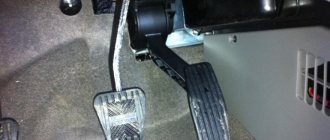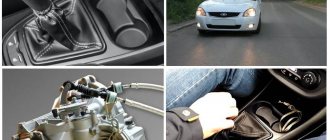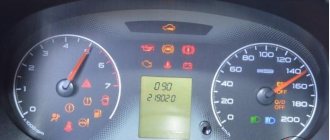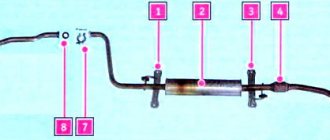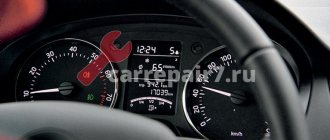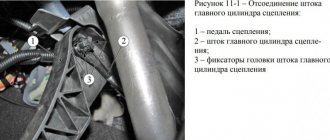This is no longer just a piece of hardware with a cable, it is a separate device. The gas pedal of the Lada Vesta car is electronic. AvtoVAZ began installing such pedals on its cars in the early 2010s, and since then it has continued to adjust its development. Until now, the pedal sometimes does not work correctly, because the factory is constantly adjusting the firmware of the ECU unit to bring the system to an ideal state. Adaptation is an electronic modification of the gas pedal to the required firmware parameters.
On Vesta cars produced in 2018-2019, this is more noticeable - an official dealer can invite car owners to reflash them. If the system continues to work incorrectly, the service may advise you to carry out a procedure called: adapting the gas pedal - this is a procedure that should be carried out without errors, otherwise the adjustment will not work. The dealer is strict, since the Lada Vesta is crammed with electronics.
Vibration of the gas pedal is not entirely normal behavior of a car, no matter what anyone says. Just like untimely throttle response, this is a problem that needs to be diagnosed and corrected.
Modification or adjustment of the electronic gas pedal (E-gas) on LADA
E-GAS or electronic gas pedal is installed on all Lada models (XRAY, Vesta, Largus, Granta, Kalina, Priora and Niva 4x4).
Owner reviews about it are not reassuring; many complain that the e-gas pedal is “dumb” (less sensitive and informative than a conventional cable). Did you know that in some cases the electronic accelerator pedal can be adjusted to be more responsive and a little livelier? We determine the model of the accelerator pedal; this can be done by the catalog number, which is glued to the side of the body. If you cannot access the sticker, you will have to remove the electronic gas pedal:
The manufacturer installs at least two types of electronic gas pedals on Lada cars (depending on the year of manufacture):
Each block is modified differently. Attention! You do all further actions at your own peril and risk. In addition, you may lose your warranty.
Electronic throttle device for Lada Vesta.
The electronic throttle system uses two throttle position sensors. TPS are part of the electrically driven throttle valve.
The TPS is a potentiometric type resistor, one of the terminals of which is supplied with a reference voltage (5 V) from the controller, and the second is supplied with ground from the controller. From the pin connected to the moving contact of the potentiometer, the TPS output signal is supplied to the controller. The controller controls the position of the throttle valve electrically, in accordance with the position of the accelerator pedal. Based on the TPS readings, the controller monitors the position of the throttle valve.
Adjusting old-style E-gas
The block cover (11183-1108500) is fixed with bolts that are inserted into oval holes. The improvement is this. to loosen the 4 screws and turn the cover in the desired direction:
In other words, we get the same effect as after installing JETTER (Jetter or spur).
It has been noticed that the first minutes after such settings, the idle speed may be increased (about 1300 rpm). But after a minute, the ECU gradually adjusted and the speed dropped to the usual level. If this does not happen, turn on the ignition for a minute and then start the engine.
If necessary, you can easily return to the original position (mark it in advance).
Diagnostic information on the electronic throttle valve of Lada Vesta.
If a fault is detected in the TPS A circuit, the engine control system will operate in emergency mode until the end of the current trip.
The following emergency modes are possible: - limiting engine power if the TPS B circuit is working; — de-energizing the electric throttle drive and limiting engine speed (2500 rpm) if the TPS-A and TPS-B circuits are faulty.
The diagnostic tool in the “Signal Monitoring” mode displays the signals TPS A (ADC parameter “Throttle sensor voltage 1” ) and TPS B (ADC parameter “Throttle sensor voltage 2” ) in volts.
When the throttle valve is opened, the TPS A signal increases, the TPS B signal decreases.
With the throttle valve fully closed, the TPS A signal should be in the range of 0.30…0.58 v, the TPS B signal should be in the range of 4.42…4.70 v. The sum of the TPS A and TPS B signals should be equal to (5±0.1) V at any throttle position.
Refinement of a new electronic gas pedal
The pedal assembly (11183-1108500-01) does not have oval holes, which does not allow adjustment in the manner described above. Instead, it is proposed to cut off the protrusion (by 2-3 mm), which prevents the pedal from moving completely. This modernization made it possible to increase the pedal travel, which made acceleration with “pedal to the floor” more active. It is also noted that there is no hesitation when pressing the pedal sharply.
What I don’t like about the pedal assembly (8450008980), which is installed on Lada Vesta:
What was decided to do:
How to measure pedal free play:
We remove and disassemble the electronic gas pedal:
We assemble the pedal assembly and install it in the car. The idle motion of the pedal should be minimal, about 1 mm. If the engine idle speed is higher than usual, and there is no free play of the pedal at all, then too much has been added. You will have to repeat the adjustment operation, adjusting the thickness of the lining. The same thing applies if the free play after adjustment remains more than 1-2 mm.
Code P0122 Low signal level of the Lada Vesta throttle position sensor.
Code P0122 is entered if:
- ignition on;
- the throttle position sensor signal voltage (ADC parameter “ Throttle sensor voltage 1 ”) is less than 0.25 V for 0.12 s.
The malfunction indicator lights up 5 s after the fault code appears.
Description of checks.
The sequence corresponds to the numbers on the card.
- Using a diagnostic tool, it is checked whether code P0122 is active at the time of diagnosis. If only code P0122 is detected, then the fault must be looked for in the signal circuit of TPS A. If codes P0122 and P0222 are detected at the same time, then the fault must be looked for in the power circuit of TPS A and TPS B.
- The circuit is checked from contact “X1.2/G2” of the controller to contact “3” of the electronic protection device.
- The controller is checked: when you bridge contacts “3” and “5” of the block to the EDS using a probe, the TPS A signal on the diagnostic device should change.
- The circuit is checked from contact “X1.2/E3” of the controller to contact “5” of the electronic protection device.
- The controller is checked: pin “5” of the block to the EDS should receive a reference voltage of 5 V from the controller.
Feedback on the E-Gas modification
Car enthusiasts who have already completed the adjustment note that if you move the pedal assembly cover clockwise, the car becomes a little more lively. If you press the pedal as before and the car starts to move, you have to get used to it and not press the gas so hard. When you press the pedal to the floor, you can't feel the difference.
Those who adjusted the E-gas for a quieter ride noticed that driving on the highway became more comfortable. Now, to maintain speed, you need to press the gas pedal a little harder, which allows your leg to not be as tense as before.
Other motorists do not believe in the positive effect, saying that it is all self-hypnosis. The operation of the electronic gas pedal is based on changing the resistance difference. And even if you move the cover, when the engine starts, the ECU will still consider it to be zero and adjust the throttle from this point. And if you increase the sector stroke, the E-gas error “signal outside the permissible limits!” will appear.
Source
Lada Vesta brake sensor and what is the connection with the electronic throttle.
If the electronic engine unit sees from the speed sensor that the car is moving and not standing still. In this case, the brake pedal is released, the throttle valve operates normally, but as soon as the driver presses the brake pedal, the electronic unit will immediately give a command to close the throttle valve so that engine braking occurs.
This is such a smart unit, this electric throttle!
Necessary tuning of Lada Vesta firmware
In general, I want to share my impressions of replacing the firmware on my Lada Vesta SW. In my opinion, all newsmakers are dissatisfied with the way the Lada Vesta drives in the first percent of pressing the gas pedal, in first, and especially in second gear. I think it’s unnecessary to talk about the twitching and lack of traction at low speeds of the 1.6l engine. Who is trying to combat these phenomena, who is putting rubber rings to seal the connection of the pipes, who is adjusting the clutch pedal end, etc. YouTube is simply replete with these methods. How do I know this... HA, I did all this myself in three years on my car, but it just doesn’t give a damn. This is where I started to think, maybe it’s not the hardware, well, although it could be, but on the other hand, everything is new, and others have it too, so I decided to try to change the engine ECU. And what to change? Again on the Internet, and as usual there is a complete abundance of authors and firmwares, I won’t name them so as not to make anti-advertising to people, saying that what I uploaded is good, but others are bad. Everything is wrong, before changing it you need to understand what you want from the car, so that it prances under you when you touch the gas pedal or so that it saves fuel or..., or... etc. After reading material on this topic for about a month and a half, I settled on two-mode firmware from Invar Inside. Great, but who will sew it? There are more than enough craftsmen on the Internet, while studying this topic I read a lot, with crooked hands and the ECU can be burned and the engine begins to heat up, in short, it’s scary. In the process, I went to the website lada-club.by, with thoughts like the community is quite large, the crooked ones have been weeded out a long time ago, and I wrote them my question. They advised me to contact Pavel and sent me his contact information. I phoned and made an appointment, and on the first day of my vacation I rushed to see him in Minsk on Aranskaya. Well, now about the firmware itself, the car starts immediately without the “proprietary” oiling of the starter, at first speed it calmly moves away without pressing the gas pedal, the feeling that it is being held by the bumper from behind has disappeared. You can easily switch to second and release the clutch without applying the gas, it doesn’t start to twitch (Hurray, comrades!), in general, it became possible to operate the clutch normally, although after three years I had to get used to “normal” at first, when starting off I got used to accelerating well, this is why the car I jumped forward, and my head was thrown back;), after two or three traffic lights I got used to it and then drove normally. One gets the impression that the car itself wants to drive, but without fanaticism, it doesn’t pull itself out, I don’t think this is what this firmware is intended for. While I was leaving Minsk, I got used to the consumption and was not distracted; I looked at the consumption in the main mode in the city when driving around Gomel, the average consumption in the area
8.4 per hundred, on the old firmware it was about the same, well a little more
8.6 per hundred, as with a noticeable increase in dynamics, it was not clear how to reduce consumption, but this is very good. The transition to the second mode (economical) is carried out with the engine turned off, you need to press the gas pedal, turn the key to turn on the ignition (without starting the starter), count down to about 7 minutes and start the engine, the sign of turning on will be a slightly longer glow of the CHEK light, turn off and turn off the engine wait about three minutes for the blocks to reset and the ECU goes into main mode, i.e. The economical one must be turned on every time the engine has been turned off. I tested the second mode on the M5 highway from Minsk to Gomel, of course, the car immediately feels much dumber when starting off, like on the old firmware or a little more, but it is not intended for urban mode, but for uniform driving along the highway. Consumption remained at the same level all the way
7.3-7.5 per hundred did not take into account the braking and acceleration modes on the cameras. There was less on the old firmware
6.9-7.2 per hundred?, I don’t know, maybe I was walking against the wind, well, well, on the 18th I’ll go to Ryazan and back if anything changes, I’ll get better. From Gomel to Dobrush on the highway driving in the main mode, the consumption was
8.0 - 8.3 per hundred, the difference with the economical one is 700-800 grams per hundred km. All the way, except for city driving, I kept 120 km/h in all modes. well +- 5-10 km. The engine behaves stably, does not overheat above normal, and the speed does not fluctuate. Well, somehow I overcame the lack of my news, I’m happy with the firmware itself. Soon a lot of goodies will come from China, I’ll write how I installed them.
Source
How to check electronic e-gas on Vesta with a multimeter
To perform an armed check of the device, remove the electronic gas module from Vesta. So, we do the following:
- Connect two probes to pins n. 2 and item 4 resistors. Click on the lever. The multimeter should show a decrease in resistance.
- Also check the contacts in pairs: 3 and 4, 1 and 6, 6 and 5.
- This will allow you to test two conductive paths in the part. If in all cases the multimeter shows a gradual decrease in resistance, the module is working.
Lada Vesta is a new car and the manifestation of “childhood diseases” can be considered quite normal. Most car manufacturers around the world also make small technological mistakes when they release brand new cars that are discontinued within the first few months of sales. Vesta has already accumulated a fair number of problems, but they cannot be called critical. In addition, we immediately note that all the shortcomings and shortcomings of the Lada Vesta collected in this article are collected from different cars.
Side windows are scratched
One of the main problems with the new Vesta is that the side windows are exposed to sand and other debris when they go up and down. Some blame the quality of the glass itself, but what looks better here is incorrectly selected gaskets, which, firstly, allow dirt to get inside the door, and secondly, subsequently all this dirt is pressed against the glass, causing them to be scratched.
Heated windshield does not work
On Lada Vesta this problem does not occur so often, but also quite often. At the factory, glass heating simply does not work for many; retailers, no doubt, change the glass itself.
Hood seals
It is unknown why this miscalculation was not corrected even during testing on pre-production samples, but the fact remains: standard hood seals are not enough to keep the engine compartment clean. Many Vesta owners are already using various methods to solve this problem.
Bad standard wipers
Another little thing you just saved up for. Many car owners have already replaced standard wipers with better ones. When replacing, look for longer wipers, which may slightly increase the glass cleaning area.
Unstable operation of the accelerator pedal
A similar problem occurred on other LADA models with an electronic accelerator pedal. On Vesta this is expressed in floating speed and triple the number of engines. In some dealerships they change the accelerator pedal and the problem disappears, in others they try to blame it on low-quality gasoline.
Problems with the radio and rear view camera
The main problem is a black screen when turning on the rear camera. Many have noticed that very often this problem occurs when AUX mode is enabled on the multimedia system. The problem should be solved by new firmware.
In some cases, the multimedia system completely refuses to boot until a full reset is performed.
Poor Jack
One of the problems that can be called global, but so far few people have used this tool and have not discovered this flaw. The jack that comes with Vesta with other tools bends after a few uses. In addition, its design requires precise installation and a level surface to stop on. By the way, a small fact - this instrument was made in Ukraine.
the hood open alarm sounded
When closing the hood while driving, the hood warning has already been enabled on several vehicles. A draft or impact causes the hood to rise slightly, causing the alarm to sound. The problem can be solved quite easily - you just need to unscrew the “lamb” of some threads.
Poor anti-corrosion treatment
Compared to other Lada models, the anti-corrosion treatment of Vesta is at a fairly high level, the most critical points are treated with an additional layer, etc. But in general, on the bottom of the car, as well as in the wheel arches, there are many places where water and dirt accumulate and in the future it is in these places that corrosion will form. Experts advise further processing immediately after purchase.
The gas tank cap does not have a lock
The lock was supposed to go into the lid of the gas tank itself or create a lockable hatch, but this was not done to save money. Of course, now cases of gasoline emissions are not so frequent, but in some regions this problem is still relevant, and Vesta owners have to buy a gas tank cap with a lock.
Problems with the robotic gearbox
The most important thing is that there is nothing to break in the box itself, but the software often does not work correctly, as a result of which the gears do not switch. Also, many have complaints about the responsiveness of AMT; if you need strong acceleration, it is better to immediately switch to manual mode and throw out a couple of gears, otherwise you will spend a few more seconds while the “robotics” thinks.
Of course, these are not all the problems that have arisen and may arise with the new Vesta, so we invite you to discuss all the problems that arise in the comments.
11 main problems of Lada Vesta: 15 comments
My driver side fan damper and system ESC button are not working.
It works, you're just probably waiting for the light on the button to light up and the order icon to light up. Why is this button needed? What's wrong with it, and without it the car behaves the same way up to 50 km/h. The only thing I noticed is that when you reverse out of a gate and, for example, the car was moving, it gets stuck. The car skids perfectly on ice and up a hill; on dry asphalt, when the car has already skidded, unnecessary systems are no longer used. But there is practically no roll even at a speed of 140 km/h on small turns of the road. As they say and write, they say that in deep snow you need to turn off the esk, but in deep snow the car will not pass, and where it does pass, it will pass with the esk. No button needed. The car is built at the end of 2022 in white, mileage is 14,000 km and there are a lot of shortcomings. The most annoying thing is the rust on the left wing. The feeling is that you can only take metallic, but in the salon I deceived myself, saying that the paint was normal. On my Kalina 1, the first rust appeared after 8 years, despite the fact that the sea was chipped.
Lada Vesta 2022 Side mirrors inside the water Side windows are scratched When the key is removed, the power windows work When the key is removed, the radio tape recorder works When the key is removed, the radio tape recorder goes from the on state to the on state When you start the engine, the radio does not turn on, it turns on only while driving, when you want it On the left side of the driver, when hitting bumps, there is a creaking sound, as if the body is playing, a plastic lining or roof is moving. In winter on ice, when you press the accelerator pedal, the front part pushes strongly to the right, and when braking, it moves to the right again. The car has driven 2,500 kilometers. How does the copyright guarantee work? How much money do you need? They say you only need 300 rubles. When is the best time to do maintenance? They say after 15 thousand How will all this happen in stages? Who knows? Please share your experience. I'm afraid that they will send me and say that everything should be like this, this is a Russian car, and not just you!
and you're still lucky. Vesta is a musical cricket! The instrument panel, air ducts, glove compartment, driver's door bounce, and creaks when driving on rough roads. Not locked, sometimes 1st gear, 2nd gear is the same. Fourth gear failed to start more than 15 times. Mileage 6800 km After repairing the gearbox, under warranty, the speed is the same, the refusal to re-insert is not included.
Get drunk in Vesta, listen to the radio and film in nature!
Soon Vesta will become the most “car” in Russia. Taxes, pensions, gasoline, housing and communal services, food - everything will raise prices. Not counting the salary. For a simple worker, a car with all its capabilities is not a pleasure. Foreign “gentlemen” will drive foreign cars. And Vesta is an expensive pleasure for a Russian.
And now the information war has been raised from the square. How is ZAZ doing?
In winter the rear does not turn on immediately
summer 2016 mileage 45 tons changed the left stabilizer strut, now the right one needs to be replaced Oil in the spark plug wells, fixed under warranty In the summer when it was hot the car curled up, washed the mesh in the fuel module there is no additional filter Now the rear shock absorber is dripping, the warranty is only two years. Arrived after three days of parking in the garage with a discharged battery, no leaks detected. In general, I am not satisfied with the car and the service; I don’t know what to expect from it.
I have St. Cross Vesta 2022, I thought for a long time before purchasing, watched the video, read the reviews. I took the plunge and bought the latest configuration. The wipers are a bit small, but they do their job flawlessly. The gearbox is a robot, but you just need to get used to it in order to understand at what point to switch to a manual. I didn't find any shortcomings, but there are some minor flaws. The hood lid does not make noise like someone else's. The mileage is over 12,000. Sometimes the electronics rarely turn on much, so I reset the ignition and just restart. The glasses don't get scratched after being lifted from behind covered, at least I didn't see anything on them. I've owned the car for five months. The 2022 models seem to have more shortcomings. Sometimes there is a humming noise under the bottom when turned on, but not always. The same sound when cooling, but not a similar sound, just the pitch of the sound. Now I don’t see anything wrong with this, the main thing is the correct implementation of these functions
Operation in winter in Siberia on a Lada vesta, mileage 20,000 km, the sides of the doors freeze very much, there is no additional door seal along the entire contour, for this reason road noise is clearly audible, I would like a better finish, there is not enough seal in the door opening, I would like to improve it , I hope the AvtoVAZ team will solve it. I had old foreign cars, and these problems simply do not exist.
I bought a Vesta after watching some great videos about it, I test drove the first Vesta, then I drove another one, I bought a Vesta 2022 and was horrified. It’s a pity that the boss who monitored quality was fired. Now they see all the crap in Vesta. First, let's start with the box - it has mechanics. Guys, don’t believe the producers who outright lie about how they passed the howling box. Actually, nothing was done to the box either. Made a little better sound insulation and that's it. But the howling became much stronger. At first it was a Priora, so only the second gear hummed there, mainly under the gas exhaust, and during acceleration the howl was not loud. On Vesta the 1st gear is now howling, the 2nd is howling terribly and the 3rd gear is also howling. And also during acceleration. Even worse, if you think everything will be fine later, you will be disappointed. The wheel bearings begin to hum. And it feels like everything at once. It is very difficult to figure out which ones, the biggest noise is at 80-90, especially when driving in neutral from 90 to 80, the trolleybus just howls, it is there even at 60, especially when starting from a stop. And when the howl manifests itself throughout the entire speed range, you lose the feeling of the quality of the car and you begin to think that it has a red price of 300 thousand!! - but costs at least 600!! Very unpleasant. Feeling deceived as a consumer. The question is where are the normal wheel bearings? Is it really that the difference of 300 rubles in the purchase price of high-quality bearings for the plant decides everything? Overall the quality is terrible. Not to mention many little things. NO MUSIC, just don't drive. No driving pleasure. (I’ve been driving without music for 1.5 months now) What also infuriates me is that the accelerator pedal is not always adequate. Sometimes you press: first nothing, then sharp gas. It turns out that traffic jams and tears are unpleasant. Having trouble getting a clean, smooth, linear throttle response? I'm happy with the starter, the car starts well, like a foreign car. And doors. I don't see anything else good, just space in the cabin. Install music and speakers, just search. I think the big minus is that the car turned out to be very rigid. Even the previous pre-restaling, in comparison with Vesta, simply stretched along the road, feeling nothing under it. And this is on 15 wheels. Manufacturers, what are you doing? People want a soft and comfortable car. Although the handling is a little worse, the Priora with hydraulic booster steered no worse, but much softer. One of these sensations (from the previous one with Shumkov) was the feeling that I was driving a Camry. And when he was transplanted into Vesta, he felt like he was sitting on some kind of hard stool. Make it softer. “I think thousands of people will be grateful to you.” It’s only difficult for Moscow and good roads, which are practically non-existent in Russia.
Of all the above, I only have problems with glass so far (Vesta sw cross 2018). I do not know what to do. I didn’t like the jack right away, so I’m using a different one.
I also changed the wipers almost immediately.
I have Vesta St., Image comfortable equipment, mechanics. Still young, so with regards to glass, electronics, etc. it’s too early to say. If we talk about howling, then like in a triple bus, it’s not a box, it’s an exhaust system, or rather, vibration is transmitted from the resonator to something, and this “something” begins to howl. “Collective Farm” is useless, even if it helps someone (you can also look it up on the Internet). Nothing helped me. It is also useless to change under warranty; if they change a resonator with a corrugated group, then on the same “tops” the hum will not disappear. And, most likely, they will say that this is the “highlight” of this model. At the VAZ, another guy changed the exhaust system, but these changes are like a dead poultice. It helps to replace the central part of the exhaust system with another one, not a VAZ one. Overall, I liked the car, but it’s a thrill, like a fly in the ointment. The accelerator pedal responds normally. I was even surprised at first to learn about the “braking” of our E-gas. Everything is going smoothly, there is no creaking in the panels, but time will tell. The gears light up with two fingers and clearly, but it happens that the second one doesn’t seem to hit and therefore doesn’t light up right away. But this happens very rarely, and only when you are in a hurry. The rear one turns on normally, then it turns on “not good” and you don’t know whether you turned it on or not. I was also unpleasantly surprised that the rear wiper lives, so to speak, its own life. When you turn the reverse on, it turns on itself. But sometimes it doesn’t turn on. At first I wanted to complain to the guarantors. But it turns out that this was taken from Renault, as if to help the driver. And the rear wiper turns on when you used the front wipers before, and not even 3 minutes have passed. And if the rear window is dry, it dries out. But this function can be disabled in the service (for money) or using various programs (the Internet is teeming with these methods). Let's go, see, listen to how this unity will behave further. Before this, the first issue of Prioress was released. So, to be honest, I did not notice a big, huge breakthrough in the automotive industry from AvtoVAZ. No, of course there are changes, but they were “donated” by Renault, Nissan and the Germans. It has an engine and a gearbox (the gearbox on Vesta seems to be ours since 2017). The car is also ours, developed jointly with the Germans. I don't know about the robot. And one more thing about the box. It turns out that you can remove all the electronics and drives from the “automatic”, and connect a “mixer” from the “mechanics”, and then make the box mechanical (you will have to connect the clutch itself). These boxes are identical. Well, just in case, all the electronics will fly away, and repairs will cost you an exorbitant amount of money (which I personally have no doubt about)
Adjusting the Accelerator pedal. Did not help.
I decided to try it. They praise it too much. My pedal is not adjustable, so I first read it here www.drive2.ru/l/489776905910747355/, and I want to write about the results.
He tore off the seal and opened it. I moved the position of the moving contact just a little bit. I returned the pedal to the car. And the accelerator pedal in the free position according to OpenDiag shows 4%. Well, I think to hell with him, he adapts. Started it up... The speed is 1500...1200...1000 and doesn’t drop. I revved it up, turned it off and started it, adapted the throttle to 0... it didn’t help.
I took it off again and moved the moving contact a little back. OpenDiag showed 3%. The car started up normally, 900 rpm, but the sound was strange. Well, I think it’s cold, it will warm up just fine. Nevermind! According to OpenDiag, the engine does not go to idle when the gas pedal is released. Although the consumption is the same as at idle.
I took a ride. And in truth, the motor is more responsive. The pedal responds willingly. But with a free pedal, the sound of the engine is kind of creepy. Not loud, but some kind of aching or whining.
Well, screw it, it’s not normal without idling, I returned it as it was from the factory. Now according to OpenDiag it is 0% with a free pedal.
This adjustment only makes sense if there is free play in the pedal. I didn't have one, but I wanted to increase responsiveness this way. But nothing useful came of it.
Source
Hi all! So my long-time dream of defeating the stupid E-gas pedal has come true! This evening I went to see a car chip technician I know and a miracle happened, it only took him 40 minutes for my car to turn from a vegetable into a speedster! I’ll immediately explain that I needed the gas pedal to adequately respond to pressing, the increase of 100-1000 Russian ponies after this process did not interest me, I already have enough engine in my car! I was pleased with the result, you press the gas and the car really drives and doesn’t stall, I don’t know what the master filled in, I just explained what I wanted and I got it! I also noticed that the car now starts with half a turn, but before it was turned on for 2-3 seconds, the fan switching on was moved to 96 degrees, the temperature gauge is now clearly at 90 degrees and does not float from 90-100 degrees, although here it’s +30 and the air conditioner is threshing all the way! Something like this, I don’t know about consumption yet, before the firmware the average was 14.5-15l/100! All the best!
How to adapt and train the electronic throttle of Lada Vesta.
If the electronic throttle body or ECM is replaced, or the controller is reset using the scan tool (Function Test; ECU Reset with Initialization mode), the Throttle Zero Adaptation procedure must be performed.
To do this, with the car standing, you need to turn on the ignition, wait 30 seconds, turn off the ignition, and wait until the main relay turns off.
Adaptation will be interrupted if:
- the engine turns over;
- the car is moving;
- the accelerator pedal is pressed;
- engine temperature is below 5 °C or above 100 °C;
- Ambient temperature is below 5 °C.
If the electric throttle actuator is de-energized, the throttle valve is held in the Limp home position (6-7%) using direct and return springs.
Gas pedal position.
Greetings to the community members.
I read somewhere that when you press the gas pedal fully, the readings are not full, but 75 or 80 percent.
I decided to check it myself using the open diag application.
And so, the engine is 129, 106 horses. The engine is not running!
When the gas pedal is not pressed. Throttle position 6.9-7 percent.
When fully pressed it shows 100 percent and the throttle position is 33 percent.
Who has any indications, just for fun?
Position of the Lada Vesta electronic throttle when starting the engine.
When the ignition is turned on, the controller sets the damper to the pre-start position, the degree of opening of which depends on the coolant temperature. In the pre-start position of the throttle valve, the output signal of TPS 1 should be within 0.58...0.70 V, the output signal of TPS 2 within 4.30...4.42 V. If you do not start the engine within 15 seconds and do not press the pedal accelerator, the controller de-energizes the electric throttle drive and the throttle valve is set to the 6-7% throttle opening position.
In the de-energized state (LIMPHOME) of the electric throttle valve drive, the output signal of TPS 1 is within 0.70...0.75 V, the output signal of TPS 2 is within 4.25...4.30 V. Further, if no action is taken for 15 seconds the check (“learning”) mode will begin 0 - the throttle valve position is completely closed and the throttle valve opens to the pre-start position, and then the electric throttle valve drive will again switch to de-energized mode.
At any throttle position, the sum of the TPS 1 and TPS 2 signals should be equal to (5±0.1) V. If a fault occurs in the TPS circuits, the controller de-energizes the electric throttle drive, stores its code in its memory and turns on the alarm. In this case, the throttle valve is set to the 6-7% throttle opening position.
A mechanical failure occurred with the owner of a Lada Vesta.
I drove for a little while after buying the car and during kickdown the car did not pick up speed and went into emergency mode, to which an acquaintance of the former owner said it was drizzling, the ABS sensor took my word for it, but in vain. And at 130,000 km I was already forced to urgently go to the service center to look for the fault; in the end, the reason turned out to be in the throttle valve because... Manufacturers made plastic gears on them and over time they ground down and broke off in some places.
SUBSCRIBE TO NEW ARTICLES VIA VK GROUP!
Subscribe
